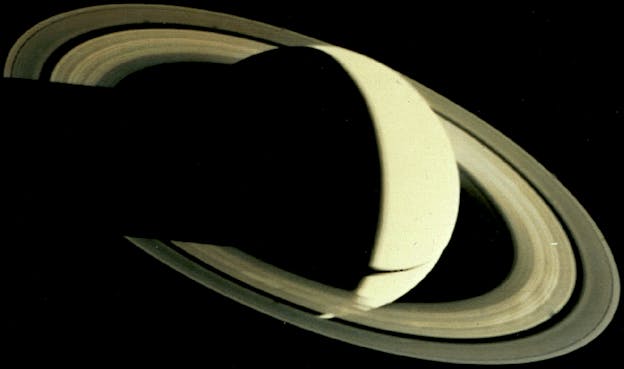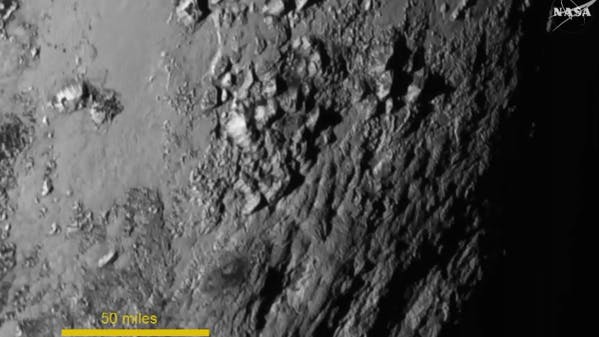Scientists may no longer consider Pluto a planet, but it remained the last unexplored world of our solar system until Tuesday, when the fastest spacecraft to ever leave Earth reached its elusive goal. New Horizons launched January 19, 2006, hurtling through space at about 34,000 miles per hour. The spacecraft has traveled 3 billion miles on its way to Pluto, which shows how far space exploration has come: The first missions to photograph planets from space traveled just 65 and 6,118 miles to capture Earth and Mars. Here are the first photos taken of every planet in our solar system.

New Horizons supplied this image taken 476,000 miles from Pluto. On Tuesday, the spacecraft came within just 7,750 miles of Pluto’s surface.

The first image from space came long before Sputnik, Neil Armstrong, and missions named Apollo. On October 24, 1946, a crew of soldiers and scientists strapped a 35-millimeter camera to a V-2 missile and launched it 65 miles above the Earth’s surface. The team had protected the film in steel casing, and when 19-year-old soldier Fred Rulli found the mangled remains of the rocket, the team celebrated the first images of Earth from space.

On July 14, 1965, exactly 50 years before New Horizons provided the first images of Pluto, Mariner 4 became the first spacecraft to photograph a planet other than Earth. The barren images dispelled any lingering scientific theories of modern life on Mars. Mariner 4 photographed and transmitted images of more than 500,000 square miles of Mars’s surface.

Mariner 10 launched on November 3, 1973 on a mission to research the atmosphere and solar winds on Earth’s neighbor. After some trajectory issues, Mariner 10 passed within 3,584 miles of Venus, and used ultraviolet filters to capture the complexity of Venus’s clouds.

After imaging Venus, Mariner 10 used the planet’s gravitational pull to slingshot towards Mercury. The spacecraft entered Mercury’s orbit in March 1974, and took more than 2,800 pictures during three passes of the planet.

On September 5, 1977, NASA began its venture further into the atmosphere with the launch of Voyager 1. This legendary spacecraft now floats far beyond our solar system in interstellar space, but in January, 1979 it began taking the first pictures of Jupiter. The imaging quality aboard Voyager 1 is greatly improved from previous spacecraft, allowing it to provide detailed images of Jupiter’s Great Red Spot and volcanic eruptions along Jupiter’s sulfuric surface.

Once past Jupiter, Voyager 1 continued to Saturn, bringing up-close images of the gaseous giant’s famed rings for the first time in November, 1980. NASA also directed Voyager 1 towards Saturn’s moon Titan to examine its atmosphere, but Titan’s gravity disrupted Voyager 1’s path, ending the original dream of passing Uranus, Neptune, and Pluto.

Confusingly, Voyager 2 launched before Voyager 1, but followed a less direct course, and reached the inner solar system planets after its partner. Despite being outperformed by Voyager 1 early on, Voyager 2 has the distinction of being the only spacecraft to have imaged Uranus and Neptune. Voyager 2 reached Neptune in January, 1986, photographed the blue giant, and discovered eleven moons.

It took Voyager 2 three-and-a-half years to make its way from Uranus to large and icy Neptune, arriving for pictures in August 1989. Voyager 2’s photographs identified Neptune’s Great Dark Spot, but observations from the Hubble Space Telescope indicate the mysterious mark no longer exists. Without the ability to navigate to Pluto, NASA directed Voyager 2 to explore Neptune’s moon Triton, ending Voyager’s two planetary exploration.
Update:
A new high resolution photograph from New Horizons highlights mountains along Pluto’s surface, with peaks as high as 11,000 feet. The image also shows an abundance of water on Pluto’s surface, and no impact craters, meaning Pluto is a relatively young member of the solar system.

